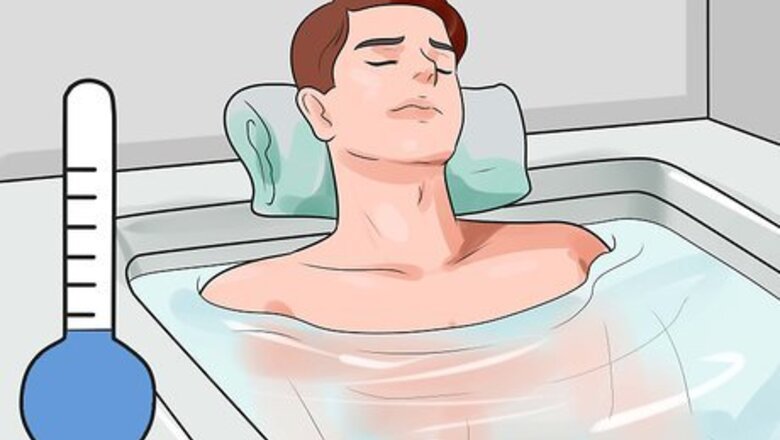
views
X
Research source
It typically develops within a few hours of being exposed to too much ultraviolet (UV) radiation, either from sunshine or artificial sources (sunlamps, tanning beds).[2]
X
Trustworthy Source
Mayo Clinic
Educational website from one of the world's leading hospitals
Go to source
Sunburn is characterized by red, inflamed skin that's painful and warm to the touch. It may take as long as two weeks for a serious sunburn to fade, and each incidence of sunburn increases your risk of various skin problems, such as wrinkles, dark spots, rashes and skin cancer (melanoma). There are many natural ways to treat and soothe sunburn at home, although medical help may be needed if your skin is really damaged.
Getting Rid of Sunburn at Home

Take a cool bath. Your skin may start to look a little pink or inflamed while at the beach or park, but you'll likely see it and feel it to a much greater extent by the time your get home a few hours later. As such, as soon as you feel and see sunburned skin, apply a cool compress or take a cool bath or shower if much of your skin is inflamed. The cool temperature of the water will help combat inflammation and soothe the pain a little. Your skin will also absorb some water, which is important for sunburned skin due to its dehydration. Soak for 15–20 minutes, making sure that the water is cool yet not too cold — adding ice to the bath may feel pretty good, but it can cause your system to go into shock. Immediately post-sunburn, do not use soap or scrub your skin — it can irritate the skin and/or further dry it out.
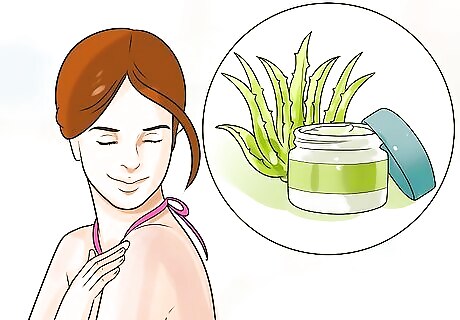
Apply aloe vera. Aloe vera gel is likely the most popular herbal remedy for sunburn and other causes of inflamed skin. Aloe vera has a tremendous ability to soothe sunburn and reduce the pain. Applying aloe vera multiple times per day for the first few days after a sunburn can make a significant impact on your skin and prevent much discomfort. If you have an actual aloe plant in your garden, break off a leaf and apply the thick inner gel/juice directly to sunburned skin. Make sure you test a small area of your skin first, however — aloe allergies are fairly common. Alternatively, buy a bottle of pure aloe gel from a pharmacy. For best effects, place the gel in the refrigerator and apply it after it becomes cool. There is conflicting evidence as to whether aloe speeds up the healing process. In at least one study, it was actually shown to slow healing.
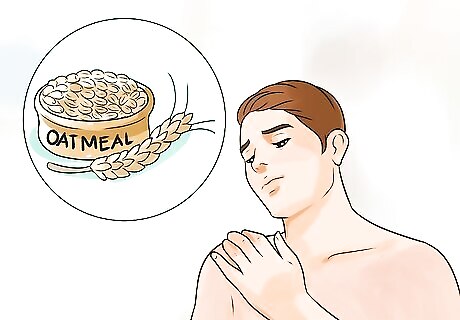
Try oatmeal. Oatmeal is another natural remedy for soothing sunburns. It works quickly to reduce inflammation and itchiness. In fact, oat extract has been shown in studies to have anti-inflammatory properties, which is helpful to soothe sunburned skin. As such, make a runny batch of oatmeal, cool it down for an hour or two in the fridge and then apply it directly to sunburned skin and let it dry. Rinse it off with cool water, but do so gently because oatmeal is also a mild exfoliant and you don't want to further irritate the skin. Alternatively, buy some finely ground oatmeal (sold as colloidal oatmeal in drug stores) and mix it in liberally with cool water in the tub before taking a bath. You can make your own finely ground oatmeal by pulverizing a cup of instant or slow-cooking oatmeal in a blender, food processor or coffee grinder until it has a smooth, fine consistency. For smaller sunburned areas, place a handful of dry oatmeal in a square of gauze and soak it in cold water for a few minutes. Then apply the home-made compress to the burn for 20 minutes every couple of hours.
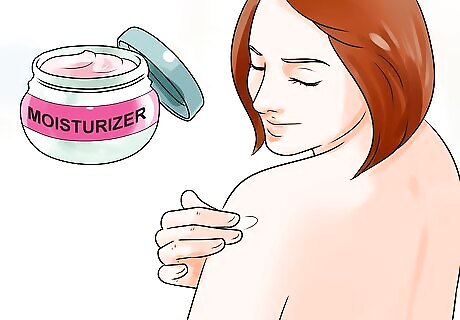
Keep the burned skin well moisturized. Sunburned skin lacks the moisture of normal skin, so another way to soothe it and stimulate healing is to keep it well moisturized. After a cool shower or bath, lather generous amounts of moisturizing cream or lotion onto sunburned skin, which will help prevent water from evaporating. Repeat applications frequently throughout the day to make the eventual peeling and flaking less noticeable. Consider natural moisturizers that contain vitamins C and E, MSM, aloe vera, cucumber extract and/or calendula — all help to soothe and help repair damaged skin. If the sunburn is particularly painful, consider applying some hydrocortisone cream. A low-dose (less than 1%) hydrocortisone cream is helpful for quickly reducing pain and swelling. Don't use creams that contain benzocaine or lidocaine — they can cause allergy in some people and make the sunburn worse. Furthermore, don't use butter, petroleum jelly (Vaseline), or other oil-based products on sunburned skin — they can trap the heat in your body, making your sunburn worse. Sunburn pain tends to be worse between six to 48 hours after sun exposure.
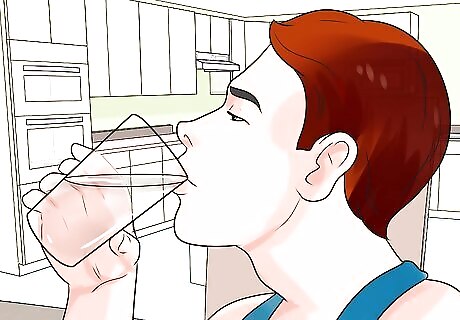
Keep yourself well hydrated. Another method of keeping your sunburned skin hydrated is to drink lots of fluids. For the duration of your sunburn (at least the initial few days), drink extra water, natural juice and/or uncaffeinated sports drinks so your body and skin can rehydrate and start to repair itself. Start with at least eight 8-oz beverages (preferably purified water) daily. Keep in mind that caffeine is a diuretic and stimulates more urination, so avoid coffee, black tea, soda pop and energy drinks during the initial stages of sunburn. Because sunburn draws fluid to the skin's surface and away from the rest of the body, keep on the lookout for symptoms of dehydration: dry mouth, excessive thirst, reduced urination, dark-colored urine, headache, dizziness and/or sleepiness. Small children are especially vulnerable to dehydration (they have a greater surface area of skin compared to their weight), so check with your doctor if they appear ill or are acting strange after getting sunburned.
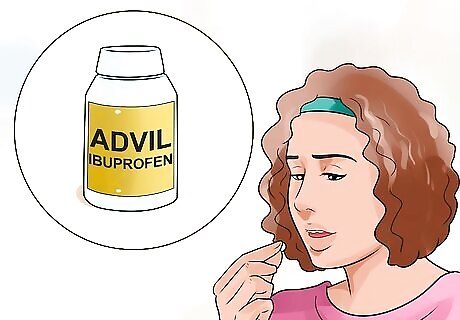
Think about taking over-the-counter NSAIDs. Inflammation and swelling is a significant problem with moderate-to-severe sunburn, so taking over-the-counter non-steroidal anti-inflammatory drugs (NSAIDs) soon after noticing the sun damage is another good strategy. NSAIDs reduce the swelling and redness that are characteristic of sunburn. Common NSAIDs include ibuprofen (Advil, Motrin), naproxen (Aleve) and aspirin, but they tend to be hard on stomachs, so take them with food and limit their use to less than two weeks. Acetaminophen (Tylenol) and other analgesics can help with the pain of sunburn, but they don't impact the inflammation and swelling. Look for creams, lotions or gels that contain NSAIDs or pain relievers — this is a potentially quicker way to get relief from the medication. Keep in mind that aspirin should not be taken by children or teenagers under 18 due to the risk of Reye's Syndrome, a potentially fatal condition.
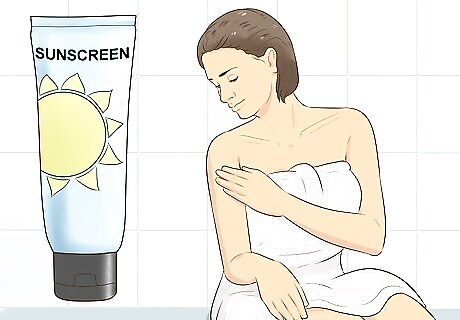
Protect yourself from further sun damage. Prevention is always your first line of defense against a sunburn. There are many things you can do to protect yourself from sunburn, including: wearing broad-spectrum sunscreen of SPF 30 or higher; reapplying sunscreen every two hours; wearing protective clothing made from tightly-woven fabrics, long-sleeved shirts, hats, sunglasses; avoiding extended exposure to the sun during peak hours (usually 10am – 4pm). Sunburn in a very light-skinned person may take less than 15 minutes of midday sun exposure, while a darker skinned person may tolerate the same exposure for hours.
Knowing When to See Your Doctor

Know when to see your doctor. Most cases of sunburn are classified as first degree burns, which can be treated at home with the above advice and staying out of the sun for awhile. However, extreme sun exposure can also cause second and third degree burns, which need medical attention and treatment. Second degree sunburn is characterized by blistered and wet looking skin, redness and damage to the entire epidermis and upper layers of the dermis. Third degree sunburn is characterized by flayed and dry looking skin, dark red or ashen color and destruction of the entire epidermis and most of the dermis. Skin sensation is usually diminished with third degree burns. Second degree sunburns heal within 10–21 days, typically without any scarring. Third degree sunburns often need skin grafts to heal and always leave scarring. Other reasons to see a doctor after a sunburn include symptoms of dehydration (see above) or heat exhaustion (heavy sweating, faintness, fatigue, weak but rapid pulse, low blood pressure and headache). For children, as a general guideline, seek medical attention if a blistering sunburn covers 20% or more of their body (a child's whole back, for example).
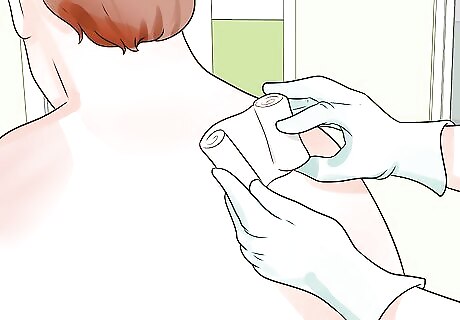
Get your blisters properly treated. Moderate-to-severe sunburn typically involves skin blistering, which is a natural protective reaction of your body. If you notice blisters form on your sunburned skin, don't pick at them or break any. Blisters contain your natural body fluid (serum) and form a protective layer over the burned skin. Breaking blisters also increases the risk of infection. If you have minimal blistering on accessible body parts (like your forearms, for example) then cover them with dry, absorbent bandages. However, if you have lots of blistering and it's on your back or other inaccessible areas, then get your doctor to care for them. Your doctor will likely apply some antibiotic cream and dress the blisters properly with sterile bandages to limit the risk of infection, minimize scarring, and promote healing. Change the bandages one to two times daily (if accessible), but remove them carefully so as to minimize further damage. Also, change the bandage immediately if it gets accidentally wet or dirty. When the blisters do break open, apply an antibiotic ointment to the area and cover loosely with another clean bandage. One or more blistering sunburns in childhood or adolescence doubles the risk of developing melanoma (a form of skin cancer) later in life.
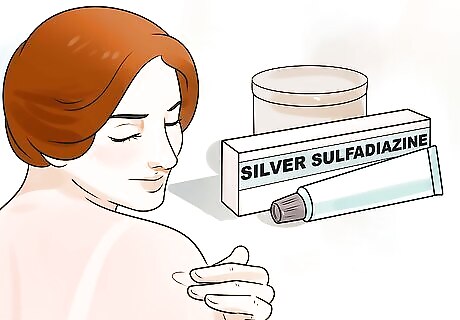
Consider silver sulfadiazine cream. If your sunburn is particularly severe and involves blistering and flaying of the skin, then your doctor may recommend and prescribe silver sulfadiazine cream (Thermazene 1%). Silver sulfadiazine is a powerful bactericidal that kills bacteria and other potentially infectious agents on burned skin. It's usually applied once or twice a day, but do not use it on the face as it can cause grayish discoloration on skin. When applying the cream, wear gloves and apply a thick layer, but make sure to remove any dead and flaky skin first. Always keep the silver sulfadiazine cream covered with sterile bandages. Colloidal silver solution, which can be purchased at many health food stores or made at home, is also a powerful antibiotic and much less expensive and problematic than silver sulfadiazine cream. Pour some colloidal silver into a sterile spray bottle and mist it over your burned skin, then let it dry before covering with bandages. If your doctor thinks widespread infection is a strong possibility due to your severe sunburn, they might prescribe a short-course of oral antibiotics to be on the safe side. Be aware that some antibiotics can cause photosensitivity, worsening chances of sunburn again — make sure you are staying out of the sun. If your sunburn is severe enough, your doctor may recommend oral steroid therapy (pills) for several days in order to combat the inflammation and pain.















Comments
0 comment